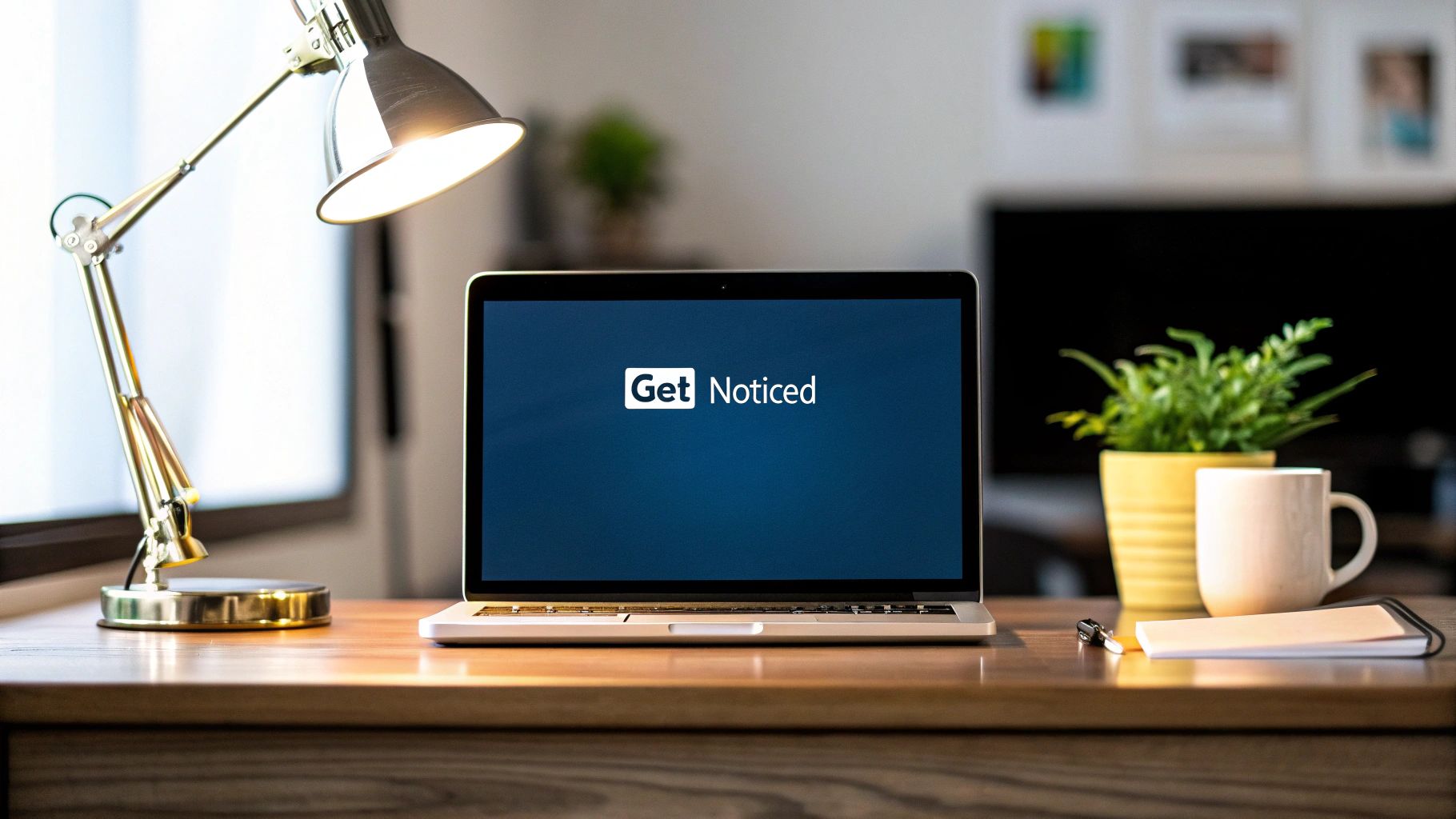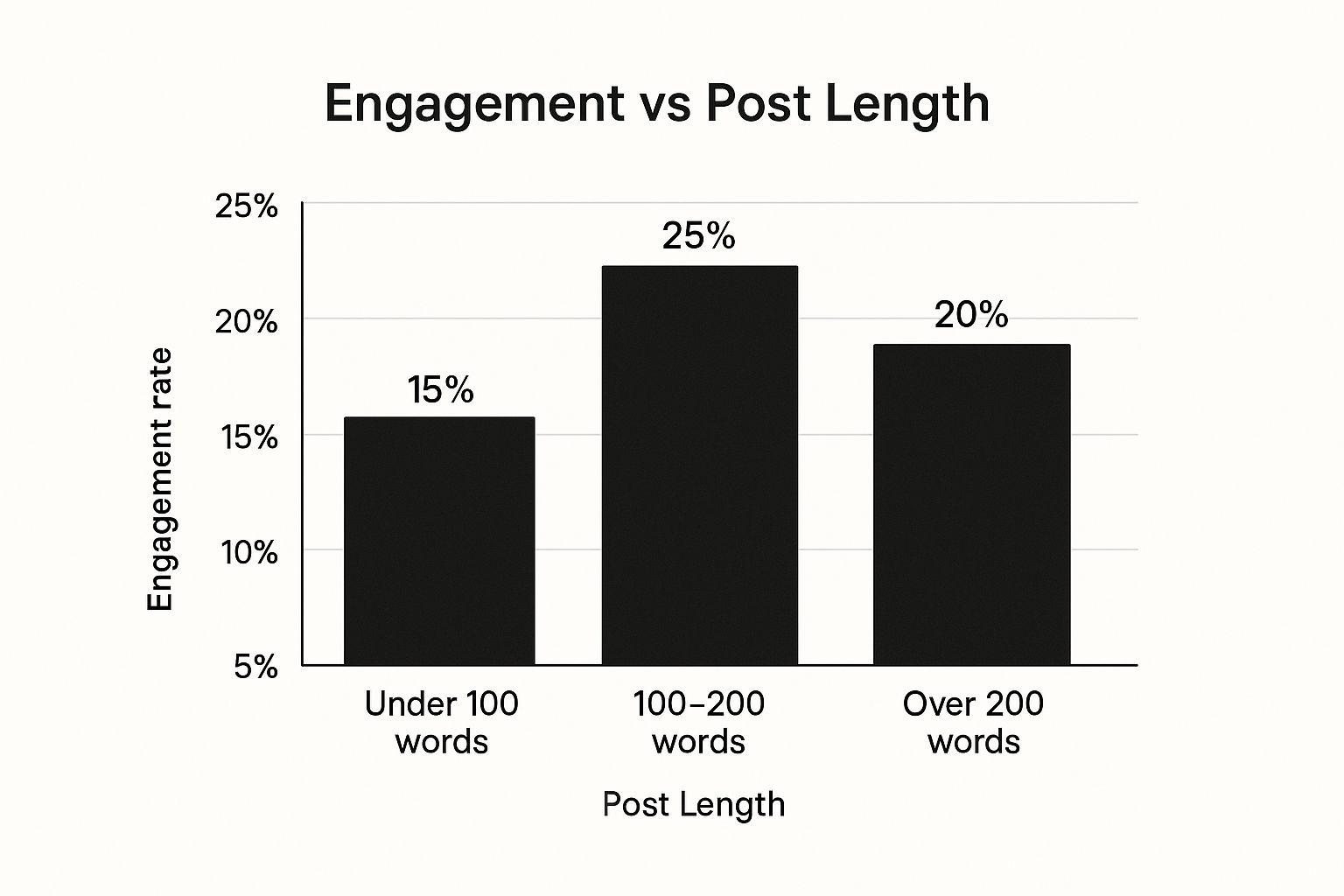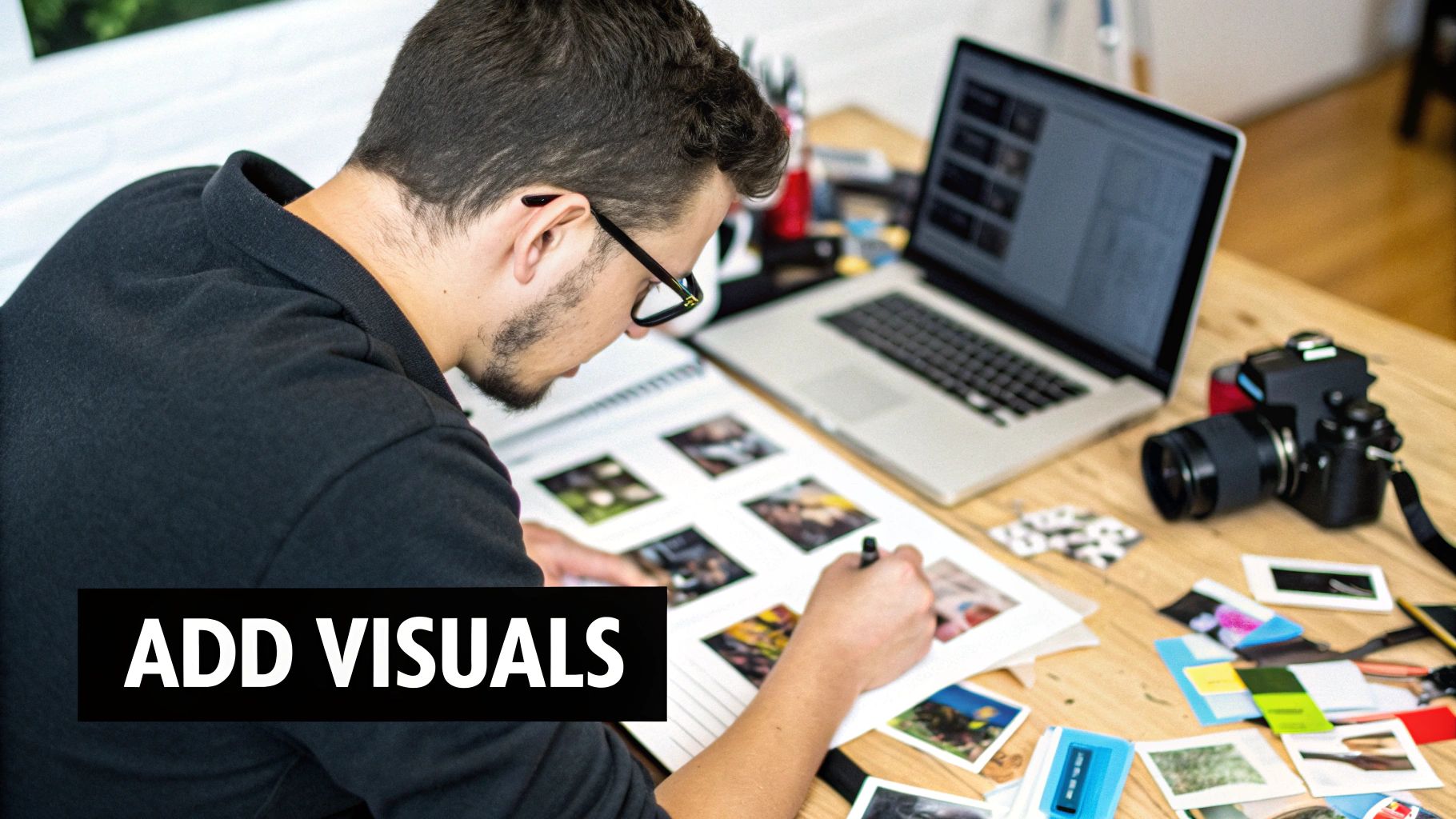
How to Write LinkedIn Post That Get Noticed and Engaged
Published on 2025-05-12
Decoding LinkedIn's Professional Audience
Before creating your first LinkedIn post, think about your audience. LinkedIn isn't like Instagram or Facebook. It’s a professional network with a unique culture and purpose. Understanding this ecosystem is critical for crafting posts that resonate and help you reach your goals, whether you're building your personal brand, generating leads, or becoming a thought leader.
Understanding the LinkedIn Mindset
Professionals on LinkedIn are driven by career goals. They look for valuable information, insightful discussions, and growth opportunities. This means your LinkedIn posts should address these aspirations. Imagine attending a virtual networking event—you wouldn't dominate the conversation with irrelevant small talk. Similarly, your posts should offer value and contribute meaningfully to professional discussions. You might be interested in: How to master building your personal brand on LinkedIn.
Demographics and Engagement Patterns
Understanding LinkedIn's user demographics is essential for writing effective posts. As of 2025, LinkedIn has 1.2 billion members, making it the world’s largest professional network. Find more detailed statistics here. The platform is especially popular with users aged 25 to 34, a core demographic for professional networking and career development. This age group actively consumes and engages with content, often looking for ways to advance their careers. For instance, one-quarter of LinkedIn users interact with brand content every day. Therefore, tailoring your content to resonate with this demographic is vital for maximizing your reach.
Targeting Specific Segments
Even within the professional world, different segments engage with content in different ways. Decision-makers, for example, are more likely to interact with content about industry trends and strategic insights. Individual contributors, however, may be more interested in content focused on skill development and career progression. Recognizing these nuances allows you to tailor your messaging for maximum impact. Content that performs well on other platforms may fall flat on LinkedIn simply because it doesn't align with this professional mindset. Successful creators understand these differences and adapt their approach accordingly. They focus on delivering value, initiating meaningful conversations, and building genuine connections within the LinkedIn community.
Headlines That Command Professional Attention

The first few seconds a user sees your LinkedIn post can determine its success. A compelling headline is essential for stopping the scroll and capturing your audience's attention. This requires understanding what makes a headline effective on the platform. Let's explore crafting headlines that consistently command professional attention.
The Psychology of a Powerful Headline
Think of your headline as a digital handshake – it's your first impression. A weak headline suggests irrelevant content. A strong headline, however, promises value and sparks curiosity. This is particularly important on LinkedIn, where users are constantly inundated with information.
For example, "Boost Your Career with These 5 Tips" is far more engaging than simply "Career Advice." The first headline offers specific value and creates a curiosity gap (what are the 5 tips?). This approach is key to capturing attention and encouraging clicks.
Headline Frameworks That Work
Some headline frameworks consistently outperform others on LinkedIn. These frameworks often address professional pain points, offer solutions, or provide valuable insights. Let's take a look at a few of the most effective options.
To help visualize these frameworks and their impact, let's examine the following table:
Headline Frameworks That Drive LinkedIn Engagement
Comparison of different headline structures and their performance on LinkedIn
| Headline Type | Example | Best For | Average Engagement |
|---|---|---|---|
| How-To | How to Write a LinkedIn Post That Gets Noticed | Providing actionable advice | High |
| Question | Are You Making These Common LinkedIn Mistakes? | Sparking curiosity and discussion | Medium |
| List | 5 Strategies for Building Your Personal Brand on LinkedIn | Delivering easily digestible information | High |
| News/Trend | New LinkedIn Feature Changes the Game for Marketers | Leveraging current events and industry buzz | Medium |
As you can see, the "How-To" and "List" headlines generally drive higher engagement due to their practical and concise nature. Question headlines can be effective for starting conversations, while News/Trend headlines capitalize on timely topics.
Crafting Compelling Curiosity Gaps
Creating a curiosity gap is vital for drawing readers in. This means hinting at valuable information without revealing everything upfront. It's important, though, to avoid clickbait, which damages your credibility.
Think of a movie trailer. It reveals just enough to pique your interest without giving away the entire plot. Your headline should similarly tease the value of your post without revealing all the details, encouraging readers to click to learn more.
Industry-Specific Terminology and Targeting
Using industry-specific terminology in your headlines helps you connect with your target audience. This signals relevance and expertise, demonstrating your understanding of their specific challenges and interests.
For example, if you're targeting marketing professionals, using terms like "SEO," "content marketing," or "lead generation" will resonate more effectively than generic terms like "marketing strategy." This targeted approach helps you connect with the right people and build credibility within your niche. After all, writing LinkedIn posts is about building connections within your professional community.
Choosing Content Formats That Professionals Devour
Crafting the perfect LinkedIn post involves more than just compelling writing. It requires a strategic approach to content formats. Different formats resonate differently with LinkedIn's professional audience. Understanding these nuances is key to maximizing your post's impact. This section explores the diverse content options on LinkedIn and reveals which formats consistently outperform others for specific goals.
Text-Only Posts: The Unexpected Powerhouse
While visual content often dominates social media, text-only posts on LinkedIn can be surprisingly effective. They provide a dedicated space for in-depth discussions and thought leadership, attracting professionals seeking valuable insights.

This infographic visualizes engagement rates based on post length: under 100 words (15%), 100-200 words (25%), and over 200 words (20%). Data suggests posts within the 100-200 word range tend to garner the highest engagement. This sweet spot balances conciseness with sufficient depth to deliver valuable information. However, longer, well-structured text posts can also thrive when addressing complex topics or sharing detailed analyses.
Images and Infographics: Visual Storytelling
Visual content, including images and infographics, can enhance engagement by breaking up text and making complex information more digestible. Infographics excel at presenting data-driven insights in a compelling and easily shareable format. Remember, visuals should always complement your written message and add value to the overall post.
Videos: Engaging the Professional Eye
Video content on LinkedIn offers a dynamic way to connect with your audience. Short, insightful videos, particularly those offering actionable advice or unique industry perspectives, can significantly boost engagement. Content engagement is crucial for successful LinkedIn posts. Video content receives five times more engagement than static posts, demonstrating the power of multimedia. Live streams achieve even higher engagement, garnering seven times the reactions and twenty-four times the comments compared to regular videos. Find more detailed statistics here.
Carousel Posts: Interactive Learning Experiences
Carousel posts provide a unique opportunity to create interactive learning experiences. These multi-slide posts allow you to break down complex ideas into bite-sized pieces, guiding your audience through a journey of information. Their interactive nature encourages users to swipe through, increasing engagement and dwell time.
Documents: Sharing Valuable Resources
LinkedIn allows you to upload documents directly to your posts, which is a valuable way to share presentations, white papers, or other resources with your network. This format positions you as a knowledgeable resource and can drive traffic to your website or other platforms.
Choosing the Right Format for Your Message
Selecting the right format hinges on understanding your message and target audience. A how-to guide might be best presented as a carousel post or short video, while industry insights could benefit from a text-only post or infographic. Experimenting with different formats and analyzing their performance helps determine what resonates best with your specific audience.
To illustrate the performance of various content formats, let's examine the following table:
Content Format Performance on LinkedIn Statistical comparison of engagement metrics across different LinkedIn content formats
| Content Format | Engagement Rate | Comment Rate | Share Rate | Best Use Cases |
|---|---|---|---|---|
| Text Posts | Moderate | Moderate | Moderate | Thought leadership, in-depth discussions |
| Images | Moderate | Low | Moderate | Visual appeal, supporting text |
| Infographics | High | Moderate | High | Data visualization, shareable insights |
| Videos | High | High | High | Demonstrations, tutorials, interviews |
| Carousel Posts | Very High | High | High | Step-by-step guides, interactive stories |
| Documents | Moderate | Low | Moderate | Sharing resources, lead generation |
This table summarizes typical performance trends observed on LinkedIn. While individual results may vary, it highlights the potential of each format. Carousel posts, for example, generate 278% more engagement than video posts, demonstrating the effectiveness of visually-driven, interactive content.
Leading creators often repurpose a single idea across multiple formats, maximizing its reach and impact. By strategically combining different formats, you can create a high-impact content ecosystem that caters to the diverse preferences of your professional audience. Consider incorporating a blend of these formats to create a dynamic and engaging LinkedIn presence.
Crafting Body Content That Professionals Can't Ignore

Your headline's job is to grab attention. Your body content's job is to deliver on that promise. This means crafting content that resonates with professionals and encourages them to keep reading. Let's explore how to create body content that achieves these objectives and makes a lasting impression on your LinkedIn audience.
Structuring for Readability and Engagement
Even the most insightful content can fall flat if it's not structured effectively. Think of your LinkedIn post as a well-designed presentation: it needs a clear beginning, middle, and end. Start with a strong introductory paragraph that expands on your headline and sets the context.
For example, if your headline is "How to Write a LinkedIn Post That Gets Noticed," your introduction could briefly touch on the importance of LinkedIn for networking and the common difficulties people encounter when trying to create engaging posts. This smoothly transitions from the headline to the content itself.
Next, develop the main body of your post using concise paragraphs. Each paragraph should focus on a single key idea. This approach dramatically improves readability, especially on mobile devices, where long paragraphs can be difficult to digest. Using subheadings (H3) further breaks up the text, allowing readers to quickly scan for relevant information.
Finally, conclude with a strong closing paragraph that summarizes your key takeaways and encourages interaction. This could be a call to action, inviting readers to share their perspectives in the comments, or a question to spark discussion. A strong conclusion reinforces your message and encourages engagement.
Balancing Vulnerability and Expertise
Effective LinkedIn posts often strike a balance between vulnerability and expertise. Sharing personal stories or experiences can make your content more relatable and build trust with your audience. However, it's essential to connect these narratives back to your professional skills and knowledge.
Vulnerability should strengthen your credibility, not replace it. Sharing a story about overcoming a professional obstacle, for example, demonstrates resilience and problem-solving abilities. This approach allows you to connect with your audience authentically while showcasing your professional strengths.
Incorporating Industry Insights and Data
Including industry insights and data significantly strengthens your LinkedIn posts. This positions you as a knowledgeable resource and provides value to your readers. Statistics and research findings can be powerful tools to support your points.
Don't just present data; analyze and interpret it, offering your unique perspective. This demonstrates critical thinking and distinguishes you from those who simply share information without adding their own insights.
Editing for Clarity and Impact
Even well-written content benefits from careful editing. Before posting, review your work for clarity, conciseness, and correct grammar. Every word should contribute to the overall message. This includes simplifying complex sentences and avoiding jargon to ensure readability. A well-edited post reflects professionalism and respects your audience's time. Crafting compelling LinkedIn content requires attention to every detail, from structure and style to the effective use of data and storytelling. By following these guidelines, you can create content that stands out, engages your audience, and helps you achieve your professional objectives on the platform.
Timing Your Posts for Maximum Visibility
Crafting a compelling LinkedIn post is essential, but knowing when to share it is equally vital. Strategic timing can significantly amplify your message, ensuring it reaches a broader audience within your professional network. This involves understanding the LinkedIn algorithm and, more importantly, your target audience's online behavior.
Understanding Peak Engagement Windows
Posting during traditional business hours isn't always the most effective strategy for LinkedIn. Activity patterns vary based on industry and seniority level. Executives, for instance, might be more active early in the morning, while junior employees might engage during lunch breaks or after work. Interested in learning more? Check out this article: How to master posting on LinkedIn.
Maximizing your LinkedIn post impact hinges on timing. Peak activity often occurs on Tuesdays to Thursdays, with mid-morning (10–11 AM) and lunchtime (12–1 PM) being prime engagement periods. Posting during these times increases your content's visibility and reach. Moreover, maintaining a consistent posting schedule, like weekly posts, results in twice as much engagement. This underscores the importance of a regular content calendar to sustain audience interest. Understanding these timing nuances helps optimize your strategy for wider reach. Explore this topic further.
Developing a Strategic Posting Calendar
Effective content creators use strategic posting calendars. This involves identifying their audience's peak engagement windows and scheduling content accordingly. This approach builds anticipation without overwhelming followers.
Think of it as primetime television scheduling. Networks strategically air popular programs during high viewership periods. Similarly, schedule your most compelling LinkedIn content when your audience is most active.
Leveraging LinkedIn's Feed Prioritization
LinkedIn prioritizes recent, engaging content. Posting during peak hours increases the likelihood of appearing higher in user feeds. However, timing alone isn't enough. Your content must also be engaging to retain visibility.
Imagine a bustling marketplace. Simply having a stall isn't enough; you need compelling offerings to attract customers. On LinkedIn, timing gets you in front of your audience, but engaging content keeps them interested.
Refining Your Timing Strategy With Data
Data analysis is key to optimizing your posting schedule. Examine past post performance, focusing on metrics like likes, comments, and shares. This offers valuable insights into when your audience is most receptive.
Continuously refine your strategy based on this data. If Wednesday mornings outperform Tuesday afternoons, adjust your schedule accordingly. This data-driven approach enhances reach and connects you with valuable professional contacts. Understanding these nuances transforms your LinkedIn presence from simply posting to strategically engaging, fostering conversations, and building a thriving community.
Sparking Meaningful Professional Conversations

LinkedIn's algorithm prioritizes genuine engagement. This means posts that encourage discussion are crucial for maximizing visibility. Let's explore the psychology behind comments and how to write LinkedIn posts that spark meaningful professional conversations.
Understanding Why Professionals Engage
Professionals comment on posts for a variety of reasons. They may want to share their own experiences, offer alternative perspectives, or connect with peers. Some aim to establish themselves as thought leaders or expand their network. Understanding these motivations is key to crafting resonant content that encourages interaction.
Think of your LinkedIn feed as a virtual networking event. Your audience is drawn to content that aligns with their professional interests, aspirations, and challenges.
Techniques for Inviting Thoughtful Responses
Several techniques can enhance your LinkedIn posts to organically invite comments. Asking open-ended questions is a highly effective method. Instead of simple "yes/no" questions, pose questions that encourage reflection and detailed responses.
For example, instead of asking "Do you use video content on LinkedIn?", try "What's your experience been with using video on LinkedIn? What challenges or successes have you encountered?" This invites your audience to share their unique perspectives.
Question Frameworks That Generate Discussion
Certain question frameworks consistently generate meaningful discussions. These often involve asking for opinions, advice, or predictions. Consider incorporating these into your posts to elicit responses:
- Seeking Opinions: "What's the biggest challenge facing your industry right now?"
- Asking for Advice: "What's one tip you'd give someone starting out in your field?"
- Predicting Trends: "What do you think the future holds for [your industry]?"
Positioning Yourself as a Thought Leader
Facilitating valuable exchanges positions you as a thought leader. This involves not just asking questions but also actively participating in the resulting discussions. Respond to comments thoughtfully, acknowledge diverse viewpoints, and steer the conversation productively.
This fosters a sense of community and builds genuine connections, establishing you as a valuable voice within your network.
Nurturing Conversations After Publishing
Starting a conversation is only the first step. Managing the discussion afterward is equally crucial. Responding promptly and thoughtfully to comments demonstrates respect for your audience and encourages further interaction.
Just as a good host wouldn't disappear after serving a meal, nurturing the conversation on your posts shows that you value the input from your connections.
Engaging Silent Observers
Not everyone who sees your post will comment. Some might simply "like" it, while others may read it without any visible interaction. However, even these silent observers can be engaged.
Consider addressing common questions or concerns that might prevent them from commenting, or offer additional insights that build upon the existing discussion. This shows responsiveness and can encourage them to participate.
Transforming Casual Commenters Into Active Advocates
By consistently nurturing conversations and providing value, you can transform casual commenters into active advocates. This means they not only engage with your content regularly, but also share it within their own networks, amplifying your reach and influence.
Building these strong relationships creates a thriving community around your LinkedIn presence, strengthening your network and solidifying your position as a respected voice in your field.
Measuring Impact and Refining Your Strategy
The most successful LinkedIn creators treat every post as a chance to learn and grow. They understand that consistent improvement relies on analyzing performance and adapting their strategies. This section explores how to use data to continuously improve your LinkedIn presence.
Key Metrics for Measuring Success
Tracking the right metrics is essential for achieving your objectives. If you're focused on brand awareness, keep an eye on impressions and reach. These show how many people saw your content. For those prioritizing engagement, likes, comments, and shares are crucial indicators of audience interaction. If your aim is to generate leads or conversions, monitor click-through rates on post links.
These metrics provide valuable insight into content effectiveness, guiding your future strategy and helping you understand what resonates with your audience.
Establishing Realistic Benchmarks
Your network size and industry play a significant role in performance. Smaller networks naturally generate fewer impressions. Engagement rates also vary across industries. Researching industry averages helps set realistic expectations.
This allows for achievable goals and effective progress measurement. For instance, if the average engagement rate in your industry is 2%, targeting 3% represents a realistic improvement.
A/B Testing for Continuous Improvement
A/B testing, also known as split testing, is a valuable technique for refining your content. It involves creating two slightly different versions of a post and comparing their performance. You could test different headlines, visuals, or calls to action.
Consider creating two posts with identical body content but different headlines. One could be a question, the other a statement. By comparing engagement metrics, you can determine which headline resonates more effectively.
Identifying Patterns in High-Performing Posts
Top content creators analyze their best-performing posts to identify common elements. They may notice that posts with certain visuals or calls to action consistently perform well. This data becomes valuable for shaping future content.
It's similar to a chef refining a recipe. They analyze successful dishes and incorporate those elements into future creations. Learn more in this article about How to Master Your LinkedIn Content Strategy.
Adapting Successful Approaches From Others
While originality is key, learning from other successful professionals in your field is beneficial. Observe their content strategies, analyze their successes, and consider how to adapt those approaches to your brand.
This isn't about copying, it's about inspiration and learning best practices. Just as musicians learn from each other while developing their own style, you can learn from others on LinkedIn while maintaining your authentic voice.
Developing a Continuous Improvement Framework
Consistent growth requires a structured approach. Develop a framework for regularly reviewing your LinkedIn performance, analyzing metrics, and implementing changes based on your findings. This cyclical process fosters continuous improvement over time.
By incorporating these techniques, you can transform your LinkedIn content from simple posts into a powerful tool for professional growth, building a strong online presence and achieving your career objectives.